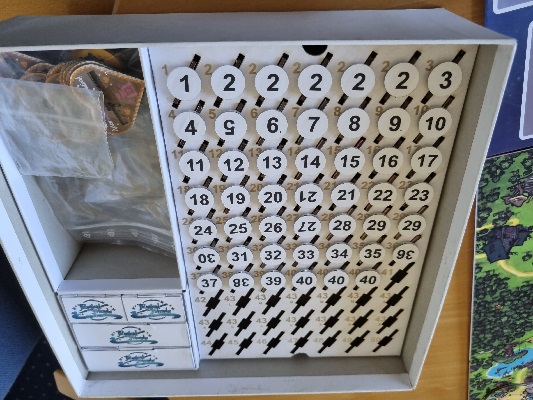an introduction
For many, games are often an opportunity to immerse themselves in alternate fantasy worlds, and even if you can call the content of most games “artificial” if you want to get pissed off, it’s very easy for me to make sense of the story to make sense of the games, if told well. Not infrequently this is a little easier with fantasy or magical themes – because they take you out of reality – and that’s how we find ourselves Magical friends… and how to summon them In a magical world full of creatures we wish to make friends with. Because Midsummer Festival is in the game and whoever brings the most friends to the festival wins the grand prize – or, in abstract terms, the game. Thus, as magicians, we try to conjure various magical creatures inside and bring them to the tavern for the big festival.
There was a game prototype available to me for this review, which is due for funding starting October 5, 2021 as part of the Kickstarter campaign. Therefore, the images do not yet show any finished game material, but rather a hand-made prototype.
game flow:
The game chest, more precisely the content, is impressive when first opened, because the magical creatures are upside down in their stands in the sorting compartment and can be drawn using the special numbers that can be found in the matching cards.
But first the game board is prepared and all players receive a board on which the name of the magician can be found, as well as a storage space for artifact cards (unused and used) and a description of the movement. This is exactly what games with more complex rules need whenever and wherever possible magical friends It can be described as an easy expert game, it is always important to observe the rules of movement, especially in the first few games.
All magicians playing together get matching gingerbread hearts, artifact cards, and other game components such as dice, Mimimi cards, and fairy dust cards. Depending on the number of players, the summon screen is equipped with three to four summon cards per screen and one or two preview cards, and the rest are placed as a drawing pile on the corresponding space next to the discard pile (archive).
Up to four parts of the plan, printed on both sides, must be placed on the board, changing the rules in some areas and providing fields on the board with special functionality. Since I don’t want to go into too much detail, I leave it as far away as possible. Finally, a round is marked on the space for the first of the eight rounds to be played.
In each round there is a novice player: in, but that only must first choose one of eleven artifact cards with values from one to eleven, which are identical for all of them. The actual round starts with whoever played the highest card, since no card can be played twice, i.e. no card played by someone else in this round can be used to avoid doubling. Then it continues to rank the values of the cards played. The turn then begins by choosing a magical creature from the screen. It can be small, medium or large and neutral, good or bad. They have basic movement and, in some cases, additional abilities like wings or magic, as well as a special ability. All other actions can be performed in any order. Among other things, the chosen creature is summoned and its width (sometimes several) is removed from the package and given the heart of its own gingerbread. In addition, the base move of the current map can be used to distribute the number of base moves on it to friends in the game – each with an amount also visible of the number of moves that cannot expire – except of course at the target. Each character may only get one basic move per turn, and if needed, move it a second time with an extra move (via some artifact cards, Mimimi energy cards, or fantasy dust cards). Bonus movements can be recognized by the green foot, while basic movements can be recognized by the white foot. Finally, some creatures can still use magic, provided they have sufficient magic power, which can be found in the form of a wand, for example in some active friend summoning cards or active artifact cards. Finally, the screen refreshes and the next magician’s turn comes: he’s in. These moves are performed over eight rounds in order and in the end the one who was able to bring the most friends to the pub at the end of the game board wins.
Special features activate the special abilities of creatures, cards, and other fields on the board. There are dangerous creatures among the creatures that can beat the creatures of other wizards and thus get them out of the game. You can also poison creatures and if this happens twice (as shown in the heart of the ginger character, which flipped after the first poisoning), then that creature is also gone. The causal person (unless you yourself) gets the corresponding heart as a keepsake and whoever was able to collect most of them eventually gets another friend for the final score.
So much for the underlying mechanisms. More details can already be found online at Game rules Read slowly. There is also an overview of creatures’ abilities, as well as rules for special fields on the game board through special alignment of the four special map tiles.

“Explorer. Communicator. Music geek. Web buff. Social media nerd. Food fanatic.”
















More Stories
A fossilized creature may explain a puzzling drawing on a rock wall.
MrBeast Sued Over ‘Unsafe Environment’ on Upcoming Amazon Reality Show | US TV
Watch comets Lemmon and SWAN approach Earth today